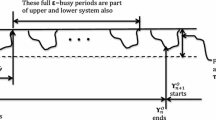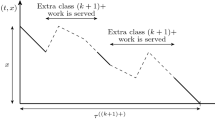Abstract
We propose a method for the control of multi-class queueing networks over a finite time horizon. We approximate the multi-class queueing network by a fluid network and formulate a fluid optimization problem which we solve as a separated continuous linear program. The optimal fluid solution partitions the time horizon to intervals in which constant fluid flow rates are maintained. We then use a policy by which the queueing network tracks the fluid solution. To that end we model the deviations between the queuing and the fluid network in each of the intervals by a multi-class queueing network with some infinite virtual queues. We then keep these deviations stable by an adaptation of a maximum pressure policy. We show that this method is asymptotically optimal when the number of items that is processed and the processing speed increase. We illustrate these results through a simple example of a three stage re-entrant line.
Similar content being viewed by others
References
Adan, I. J. B. F., & Weiss, G. (2005). A two node Jackson network with infinite supply of work. Probability in Engineering and Informational Sciences, 19, 191–212.
Adan, I. J. B. F., & Weiss, G. (2006). Analysis of a simple Markovian re-entrant line with infinite supply of work under the LBFS policy. Queueing Systems Theory and Applications, 54, 169–183.
Anderson, E. J. (1981). A new continuous model for job-shop scheduling. International Journal Systems Science, 12, 1469–1475.
Anderson, E. J., & Nash, P. (1987). Linear programming in infinite dimensional spaces. Chichester: Wiley-Interscience.
Avram, F., Bertsimas, D., & Ricard, M. (1995). Fluid models of sequencing problems in open queueing networks: an optimal control approach. In F. P. Kelly & R. Williams (Eds.), IMA volumes in mathematics and its applications: Vol. 71. Stochastic networks (pp. 199–234). New York: Springer.
Bellman, R. (1953). Bottleneck problems and dynamic programming. Proceedings National Academy of Science, 39, 947–951.
Bramson, M. (1998). State space collapse with application to heavy traffic limits for multiclass queueing networks. Queueing Systems Theory and Applications, 30, 89–148.
Chen, H., & Yao, D. (1993). Dynamic scheduling of a multi class fluid network. Operations Research, 41, 1104–1115.
Chen, M., Pandit, C., & Meyn, S. P. (2003). In search of sensitivity in network optimization. Queueing Systems Theory and Applications, 44, 313–363.
Chen, R. R., & Meyn, S. P. (1999). Value iteration and optimization of multiclass queueing networks. Queueing Systems Theory and Applications, 32, 65–97.
Connors, D., Feigin, G., & Yao, D. (1994). Scheduling semiconductor lines using a fluid network model. IEEE Transactions on Robotics and Automation, 10, 88–98.
Dai, J. G. (1995). On positive Harris recurrence of multi-class queueing networks: a unified approach via fluid limit models. Annals of Applied Probability, 5, 49–77.
Dai, J. G., & Lin, W. (2005). Maximum pressure policies in stochastic processing networks. Operations Research, 53, 197–218.
Dai, J. G., & Lin, W. (2006). Asymptotic optimality of maximum pressure policies in stochastic processing networks. Annals of Applied Probability (submitted).
Fleischer, L., & Sethuraman, J. (2003). Approximately optimal control of fluid networks. IBM Research Report
Goemans, M. X., & Williamson, D. P. (1996). The primal dual method for approximation algorithms and its application to network design problems. In D. Hochbaum (Ed.) Approximation algorithms (pp. 144–191).
Harrison, J. M. (1988). Brownian models of queueing networks with heterogeneous customer populations. In W. Fleming & P. L. Lions (Eds.), Proceedings of the IMA workshop on stochastic differential systems. Berlin: Springer.
Harrison, J. M. (1996). The BIGSTEP approach to flow management in stochastic processing networks. In F. P. Kelly, S. Zachary, & I. Ziedins (Eds.), Royal statistical society lecture note series: Vol. 4. Stochastic networks: theory and applications (pp. 147–186). Oxford: Oxford University Press.
Harrison, J. M. (2000). Brownian models of open processing networks: canonical representation of workload. Annals of Applied Probability, 10, 75–103.
Harrison, J. M. (2001). A broader view of Brownian networks. Annals of Applied Probability, 13, 1119–1150.
Harrison, J. M. (2002). Stochastic networks and activity analysis. In Y. Suhov (Ed.), Analytic methods in applied probability, In memory of Fridrik Karpelevich. Providence: American Mathematical Society.
Harrison, J. M., & Van Mieghem, J. (1997). Dynamic control of Brownian networks: State space collapse and equivalent workload formulations. Annals of Applied Probability, 7, 747–771.
Kelly, F. P., & Laws, C. N. (1993). Dynamic routing in open queueing networks: Brownian models, cut constraints and resource pooling. Queueing Systems Theory and Applications, 13, 47–86.
Kopzon, A., & Weiss, G. (2002). A push pull queueing system. Operations Research Letters, 30, 351–359.
Kopzon, A., & Weiss, G. (2007). A push pull system with infinite supply of work. Preprint.
Kushner, H. J. (2001). Heavy traffic analysis of controlled queueing and communication networks. Berlin: Springer.
Lawler, E. L., Lenstra, J. K., Rinnooy Kan, A. H. G., & Shmoys, D. B. (1993). Sequencing and scheduling, algorithms and complexity. In S. C. Graves & A. H. G. Rinnooy (Eds.), Handbooks in operations research and management science: Vol. 4. Logistics of production and inventory. Amsterdam: North Holland.
Maglaras, C. (1999). Dynamic scheduling in multiclass queueing networks: Stability under discrete-review policies. Queueing Systems Theory and Applications, 31, 171–206.
Maglaras, C. (2000). Discrete-review policies for scheduling stochastic networks: Trajectory tracking and fluid-scale asymptotic optimality. Annals of Applied Probability, 10, 897–929.
Meyn, S. P. (2001). Sequencing and routing in multiclass queueing networks. Part I: Feedback regulation. SIAM Journal Control and Optimization, 40, 741–776. IEEE international symposium on information theory. Sorrento, Italy, June 25 – June 30 2000.
Meyn, S. P. (2003). Sequencing and routing in multiclass queueing networks. Part II: Workload relaxations. SIAM Journal Control and Optimization, 42, 178–217.
Shah, S., & Nahrstedt, K. (2002). Predictive location-based QoS routing in mobile ad hoc networks. In Proceedings of IEEE international conference on communications.
Pullan, M. C. (1993). An algorithm for a class of continuous linear programs. SIAM Journal Control and Optimization, 31, 1558–1577.
Stolyar, A. L. (2004). MaxWeight scheduling in a generalized switch: State space collapse and equivalent workload minimization under complete resource pooling. Annals of Applied Probability, 14(1), 1–53.
Tassiulas, L. (1995). Adaptive back-pressure congestion control based on local information. IEEE Transactions on Automatic Control, 40, 236 Ð-250.
Wein, L. M. (1992). Scheduling networks of queues: Heavy traffic analysis of a multistation network with controllable inputs. Operations Research, 40, S312–S334.
Weiss, G. (1999). Scheduling and control of manufacturing systems—a fluid approach. In Proceedings of the 37 Allerton conference, Monticello, Illinois 21–24, September 1999, (pp. 577–586).
Weiss, G. (2005). Jackson networks with unlimited supply of work. Journal of Applied Probability, 42, 879–882.
Weiss, G. (2008). A simplex based algorithm to solve separated continuous linear programs. Mathematical Programming, 115, 151–198.
Williams, R. J. (1998). Diffusion approximations for open multiclass queueing networks: sufficient conditions involving state space collapse. Queueing Systems Theory and Applications, 30, 27–88.
Author information
Authors and Affiliations
Corresponding author
Additional information
Research supported in part by Israel Science Foundation Grant 249/02 and 454/05 and by European Network of Excellence Euro-NGI.
Rights and permissions
About this article
Cite this article
Nazarathy, Y., Weiss, G. Near optimal control of queueing networks over a finite time horizon. Ann Oper Res 170, 233–249 (2009). https://doi.org/10.1007/s10479-008-0443-x
Published:
Issue Date:
DOI: https://doi.org/10.1007/s10479-008-0443-x




